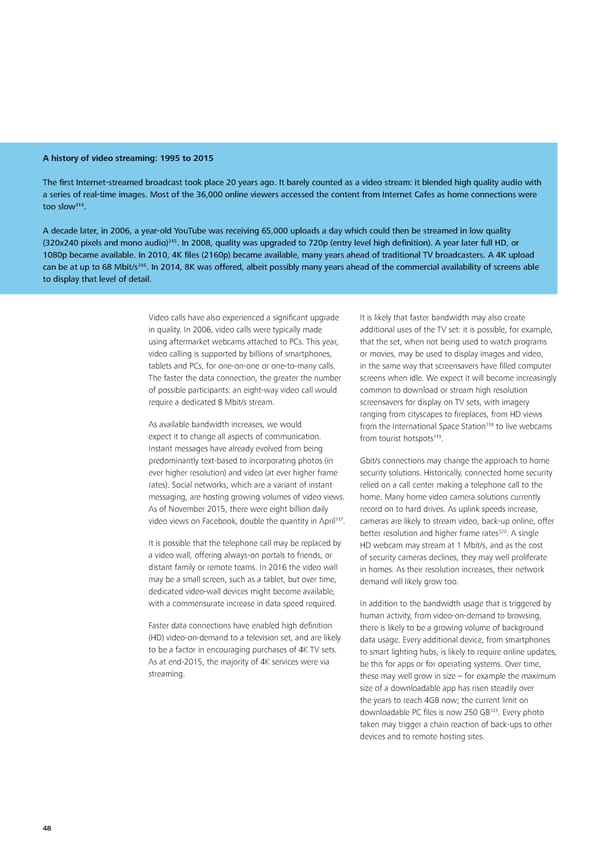A history of video streaming: 1995 to 2015 The first Internet-streamed broadcast took place 20 years ago. It barely counted as a video stream: it blended high quality audio with a series of real-time images. Most of the 36,000 online viewers accessed the content from Internet Cafes as home connections were 314 too slow . A decade later, in 2006, a year-old YouTube was receiving 65,000 uploads a day which could then be streamed in low quality 315 (320x240 pixels and mono audio) . In 2008, quality was upgraded to 720p (entry level high definition). A year later full HD, or 1080p became available. In 2010, 4K files (2160p) became available, many years ahead of traditional TV broadcasters. A 4K upload 316 can be at up to 68 Mbit/s . In 2014, 8K was offered, albeit possibly many years ahead of the commercial availability of screens able to display that level of detail. Video calls have also experienced a significant upgrade It is likely that faster bandwidth may also create in quality. In 2006, video calls were typically made additional uses of the TV set: it is possible, for example, using aftermarket webcams attached to PCs. This year, that the set, when not being used to watch programs video calling is supported by billions of smartphones, or movies, may be used to display images and video, tablets and PCs, for one-on-one or one-to-many calls. in the same way that screensavers have filled computer The faster the data connection, the greater the number screens when idle. We expect it will become increasingly of possible participants: an eight-way video call would common to download or stream high resolution require a dedicated 8 Mbit/s stream. screensavers for display on TV sets, with imagery ranging from cityscapes to fireplaces, from HD views As available bandwidth increases, we would 318 from the International Space Station to live webcams expect it to change all aspects of communication. 319 from tourist hotspots . Instant messages have already evolved from being predominantly text-based to incorporating photos (in Gbit/s connections may change the approach to home ever higher resolution) and video (at ever higher frame security solutions. Historically, connected home security rates). Social networks, which are a variant of instant relied on a call center making a telephone call to the messaging, are hosting growing volumes of video views. home. Many home video camera solutions currently As of November 2015, there were eight billion daily record on to hard drives. As uplink speeds increase, 317 video views on Facebook, double the quantity in April . cameras are likely to stream video, back-up online, offer 320 better resolution and higher frame rates . A single It is possible that the telephone call may be replaced by HD webcam may stream at 1 Mbit/s, and as the cost a video wall, offering always-on portals to friends, or of security cameras declines, they may well proliferate distant family or remote teams. In 2016 the video wall in homes. As their resolution increases, their network may be a small screen, such as a tablet, but over time, demand will likely grow too. dedicated video-wall devices might become available, with a commensurate increase in data speed required. In addition to the bandwidth usage that is triggered by human activity, from video-on-demand to browsing, Faster data connections have enabled high definition there is likely to be a growing volume of background (HD) video-on-demand to a television set, and are likely data usage. Every additional device, from smartphones to be a factor in encouraging purchases of 4K TV sets. to smart lighting hubs, is likely to require online updates, As at end-2015, the majority of 4K services were via be this for apps or for operating systems. Over time, streaming. these may well grow in size – for example the maximum size of a downloadable app has risen steadily over the years to reach 4GB now; the current limit on 321 downloadable PC files is now 250 GB . Every photo taken may trigger a chain reaction of back-ups to other devices and to remote hosting sites. 48
 Technology, Media & Telecommunications Predictions Page 56 Page 58
Technology, Media & Telecommunications Predictions Page 56 Page 58